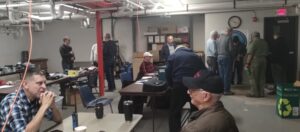2025 Amateur Radio Public Service/Events Calendar (N. IL)
volunteer events:
• HT Equipment (radio, extra battery)
• Optional HT Equipment (external mic, earpiece, antenna better than stock)
• Info (organizer info, frequency plan, map, copy of your FCC license)
• Prep (load frequencies into memory, review instructions, plan departure/arrival time/parking)
• Clothing (layered outerwear, hat, sunglasses, water-proof gloves, yellow safety vest*)
• Other (water, sunscreen, snacks, cellphone, pen/paper)
DATE NAME (web link) TYPE RADIO ORGANIZER (email link) LOCATION
Mar 23 Bank of America Shamrock Shuffle
May 4 MS Walk 1mi, 3mi walk
Schaumburg Amateur Radio Club Itasca, IL Monitor route
May 4 MS Walk 1mi, 3mi walk
Fox River Radio League (FRRL) St Charles, IL Monitor route
5 May 10 Starved Rock CountryMarathon 26.2mi, 13.1mi, 5K run Various Ottawa, IL GMRS too as backup
May 18 Darien Dash 5K &10K run, 1mi run/walk DuPage Amateur Radio Club Darien, IL Supports community needs
May 18 Lilac Festival Parade 1.5mi parade
departure, route monitoring
May 26 Elmhurst Memorial DayParade Parade Elmhurst, IL Check-in units, sequence
departure, route monitoring
Jun 1 Bank of America Chicago 13.1 13.1mi run Ham Radio Chicago West side of Chicago, IL Starts/finishes in Garfield Park
Jun 7 MACC Fund Trek 100 24mi, 35mi, 62mi, 100mi
bike North Shore Amateur Radio Club Waterloo, WI Supports childhood cancer
research. More details here.
Jun 29 Swedish Days Ride 12, 28, 51, 73, 103, 133mi
bike Randy Broadwell Sandwich, IL Sag, rover, command… supporting
Easter Seals and Project Mobility
11 Jul 4 Hoffman Estates 4th of July
Parade Parade Schaumburg Amateur Radio Club Hoffman Estates, IL Check-in units, sequence
departure, route monitoring
Jul 4 Wheaton 4th of July Parade Parade , IL Check-in units, sequence
departure, route monitoring
Jul 28 Schaumburg Triathlon 400m swim, 12.8m bike,
5K run Schaumburg Amateur Radio Club Schaumburg, IL Route monitoring, etc.
Oct 10 Chicago Marathon 26.2K run Ham Radio Chicago Chicago, IL Supports over 200 charities
Nov 2 Ohh LaLa Chocolate Half
Marathonwalk Ham Radio Chicago Geneva, IL Benefits St. Jude Children’s
Research Hospital.
Nov 27 Grove Express 5K run

